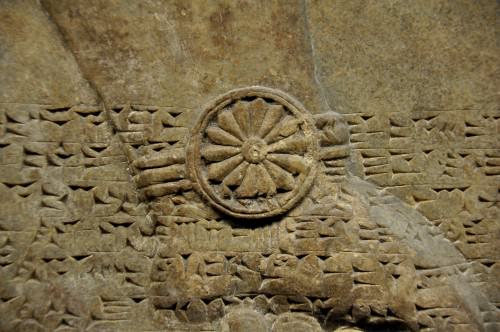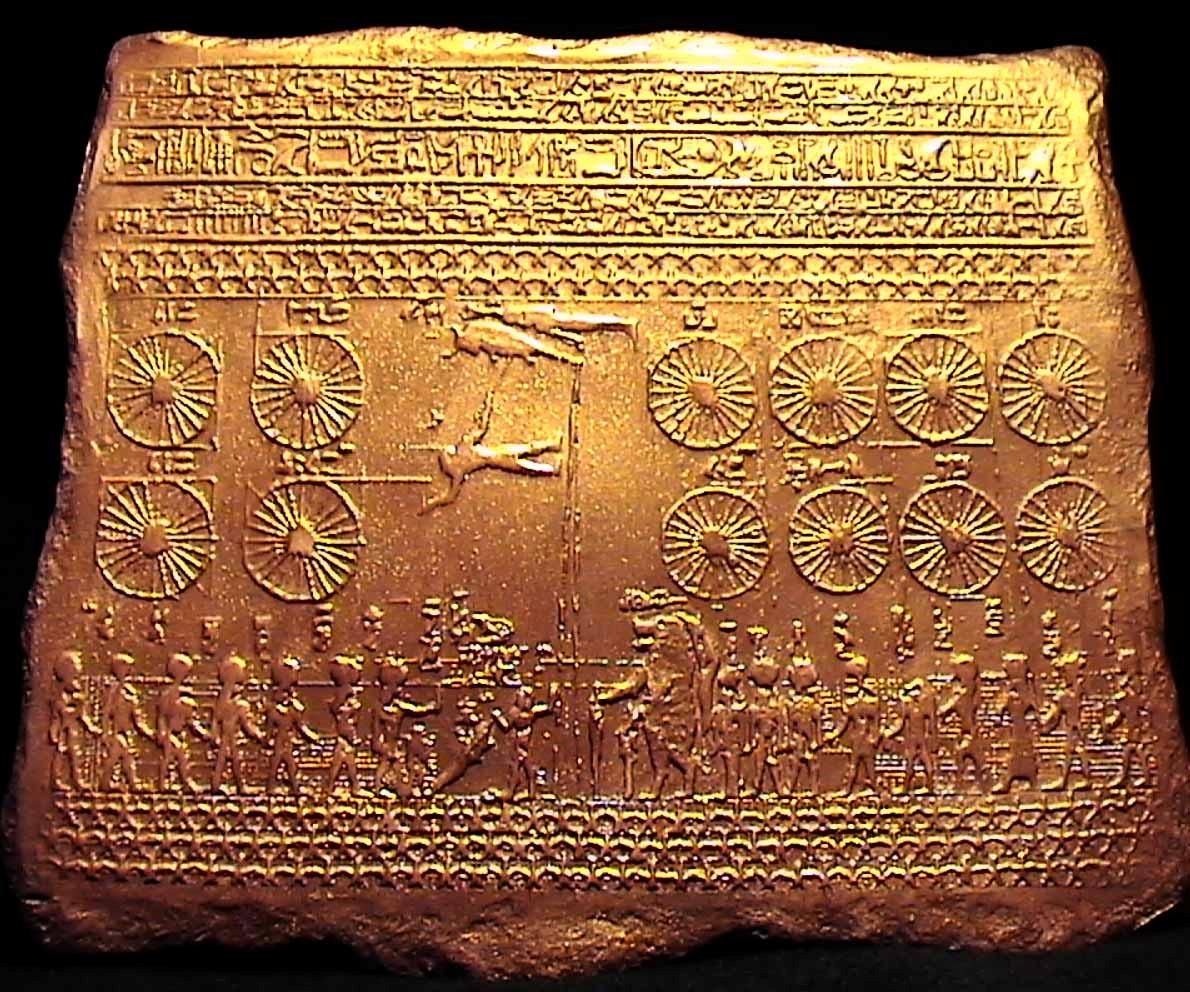nivek
As Above So Below
What is the Mysterious Handbag Seen in Ancient Carvings Across Cultures and Countries?

Assyrian relief carving, 883 – 859 BC. Metropolitan Museum of Art.
One of the more mysterious symbols that has been found in ancient carvings is an image that looks uncannily like a handbag. The shape appears in depictions made by the Sumerians of Iraq, in the ruins of ancient Turkish temples, in decorations of the Maori of New Zealand, and in crafts made by the Olmecs of Central America.
Handbags can be seen in the art of disparate cultures from around the world and throughout time, with the first known instance of a handbag appearing at the end of the Ice Age. What is this mysterious symbol that can be found throughout the ancient world?
A Representation of the Cosmos?
The handbag image is so called because it looks very similar to the modern-day purse. The objects “typically feature a rounded handle-like top and a rectangular bottom, and may include varying degrees of additional details of texture or pattern” (Scranton, 2016).
The images sometimes appear as stand-alone objects; sometimes they are depicted in the hand of a person, god, or mythical being in a manner similar to how one would hold a basket.
One possible theory for the proliferation of this image is its simple and straightforward representation of the cosmos. The semi-circle of the image (what would appear to be the bag’s strap) represents the hemisphere of the sky. Meanwhile, the solid square base represents the earth.
“In ancient cultures from Africa to India to China, the figure of a circle was associated symbolically with concepts of spirituality or non-materiality, while that of a square was often associated with concepts of the Earth and of materiality” (Scranton, 2016). Thus, the image is used to symbolize the (re)unification of the earth and sky, of the material and the non-material elements of existence.

Assyrian relief carving from Nimrud, 883–859 B.C. (Metropolitan Museum of Art)
Oldest Depictions of the ‘Handbag’
One of the earliest instances of the handbag motif can be seen in the ruins of Göbekli Tepe, located at the top of a mountain ridge in southeastern Turkey. Dating back to approximately 11,000 BC, Göbekli Tepe is one of the oldest temple complexes ever discovered (Tinfoil Hat, 2014).
The exact purpose of the mountain sanctuary is unknown; however, it appears that temple may have served as a site for religious sacrifices (archaeologists unearthed many butchered animal bones). The walls and pillars of the temple are decorated with finely carved animals, gods, and mythical creatures, perhaps in an effort to portray the many different creations of the cosmos. Amidst these other carvings are three handbags.
Experts believe that early religions worshiped the fundamental elements of life on earth. Therefore, “the three Göbekli Tepe handbags, taken as an early form of those icons, could be said to symbolically define the site as a temple” (Scranton, 2016).

Pillar 43 from Gobekli Tepe in Turkey shows three ‘handbag’ carvings along the top. Credit: Alistair Coombs
From the Middle East to South America, the Strange Carving Can Be Found
Elsewhere, the handbag image shows up with striking similarities in two stone reliefs, one made by the Assyrians of ancient Iraq sometime between 880-859 BC and the other made by the Olmecs of ancient Mesoamerica sometime between 1200 – 400 BC. In both of these images, a man-like figure carries the handbag in his hand, as if it were a basket or purse.
“When used in Assyrian art it is said the purse holds magic dust. When depicted in Olmec art they postulate it contains herbs for getting high” (Freeborn, 2013). This suggests that the handbag may have been a standard of measurement uniquely discovered by both cultures.

Olmec Monument 19, from La Venta, Tabasco, shows a man holding the handbag in his hand. (Xuan Che)
Another instance of ancient handbag imagery can be found in faraway New Zealand. A Maori myth tells of a hero who once ascended to the home of the gods and returned to earth carrying three baskets full of wisdom. Thus, much like the Göbekli Tepe handbags, the Maori handbags symbolize worship and gratitude for divinely inspired knowledge.
Finally, in ancient Egyptian hieroglyphs, the handbag-like image can be seen. This time serving as a home for the gods and goddesses, with the purse straps being the domed poles of the portable tent and the square bottom being the cloth or animal skins laid across the poles. This structure is quite similar to the Native American teepee or the central Asian yurt.
The many instances of this symbol seem to confirm the use of a handbag as a cosmological symbol represented as a commonplace household item (a basket that is, not the handbag) so as to be better understood by ordinary people.

Assyrian relief carving, 883 – 859 BC. Metropolitan Museum of Art.
One of the more mysterious symbols that has been found in ancient carvings is an image that looks uncannily like a handbag. The shape appears in depictions made by the Sumerians of Iraq, in the ruins of ancient Turkish temples, in decorations of the Maori of New Zealand, and in crafts made by the Olmecs of Central America.
Handbags can be seen in the art of disparate cultures from around the world and throughout time, with the first known instance of a handbag appearing at the end of the Ice Age. What is this mysterious symbol that can be found throughout the ancient world?
A Representation of the Cosmos?
The handbag image is so called because it looks very similar to the modern-day purse. The objects “typically feature a rounded handle-like top and a rectangular bottom, and may include varying degrees of additional details of texture or pattern” (Scranton, 2016).
The images sometimes appear as stand-alone objects; sometimes they are depicted in the hand of a person, god, or mythical being in a manner similar to how one would hold a basket.
One possible theory for the proliferation of this image is its simple and straightforward representation of the cosmos. The semi-circle of the image (what would appear to be the bag’s strap) represents the hemisphere of the sky. Meanwhile, the solid square base represents the earth.
“In ancient cultures from Africa to India to China, the figure of a circle was associated symbolically with concepts of spirituality or non-materiality, while that of a square was often associated with concepts of the Earth and of materiality” (Scranton, 2016). Thus, the image is used to symbolize the (re)unification of the earth and sky, of the material and the non-material elements of existence.

Assyrian relief carving from Nimrud, 883–859 B.C. (Metropolitan Museum of Art)
Oldest Depictions of the ‘Handbag’
One of the earliest instances of the handbag motif can be seen in the ruins of Göbekli Tepe, located at the top of a mountain ridge in southeastern Turkey. Dating back to approximately 11,000 BC, Göbekli Tepe is one of the oldest temple complexes ever discovered (Tinfoil Hat, 2014).
The exact purpose of the mountain sanctuary is unknown; however, it appears that temple may have served as a site for religious sacrifices (archaeologists unearthed many butchered animal bones). The walls and pillars of the temple are decorated with finely carved animals, gods, and mythical creatures, perhaps in an effort to portray the many different creations of the cosmos. Amidst these other carvings are three handbags.
Experts believe that early religions worshiped the fundamental elements of life on earth. Therefore, “the three Göbekli Tepe handbags, taken as an early form of those icons, could be said to symbolically define the site as a temple” (Scranton, 2016).

Pillar 43 from Gobekli Tepe in Turkey shows three ‘handbag’ carvings along the top. Credit: Alistair Coombs
From the Middle East to South America, the Strange Carving Can Be Found
Elsewhere, the handbag image shows up with striking similarities in two stone reliefs, one made by the Assyrians of ancient Iraq sometime between 880-859 BC and the other made by the Olmecs of ancient Mesoamerica sometime between 1200 – 400 BC. In both of these images, a man-like figure carries the handbag in his hand, as if it were a basket or purse.
“When used in Assyrian art it is said the purse holds magic dust. When depicted in Olmec art they postulate it contains herbs for getting high” (Freeborn, 2013). This suggests that the handbag may have been a standard of measurement uniquely discovered by both cultures.

Olmec Monument 19, from La Venta, Tabasco, shows a man holding the handbag in his hand. (Xuan Che)
Another instance of ancient handbag imagery can be found in faraway New Zealand. A Maori myth tells of a hero who once ascended to the home of the gods and returned to earth carrying three baskets full of wisdom. Thus, much like the Göbekli Tepe handbags, the Maori handbags symbolize worship and gratitude for divinely inspired knowledge.
Finally, in ancient Egyptian hieroglyphs, the handbag-like image can be seen. This time serving as a home for the gods and goddesses, with the purse straps being the domed poles of the portable tent and the square bottom being the cloth or animal skins laid across the poles. This structure is quite similar to the Native American teepee or the central Asian yurt.
The many instances of this symbol seem to confirm the use of a handbag as a cosmological symbol represented as a commonplace household item (a basket that is, not the handbag) so as to be better understood by ordinary people.






 A
A

